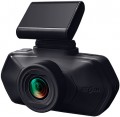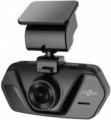Dashcam mount
A method of fixing the recorder on a device that plays the role of a mount - a bracket for the windshield, a helmet platform, a clamp for the steering wheel or another similar structure.
—
Latch. One of the most popular options nowadays. The latch, along with the magnet (see below), refers to
quick-release fasteners, allowing you to easily and quickly remove the device and return it to its place. This feature can be useful, for example, if the car is left overnight in an unguarded place, where an unremoved recorder can become a bait for thieves; In addition, the entire device sometimes has to be removed to view and copy footage. Specifically, latches are considered more reliable than magnets; they can be used even with the most massive devices, and are also cheaper to produce.
-
Magnet. Another type of quick-release mount: a powerful permanent magnet that is strong enough to hold the recorder in place. This type of fastener is easier to use than a latch: to install it, just “stick” the device to the mount, and to remove it, just pull it hard. Another advantage is that the latch can be broken by unsuccessfully applying force, whereas in magnets there is practically nothing to break. On the other hand, this type of mount is less reliable: in the event of a shock or a powerful jerk, the force of attraction may not be enough. Therefore, although magnets ar
...e widespread, they are still inferior in popularity to latches.
— Magnet/latch. An option that involves the presence of both types of mount in the kit - both a magnet and a latch. This allows you to choose an option at your discretion depending on the situation. For example, for quiet movement around the city and frequent stops during which you have to remove the recorder, a magnet is better suited, and a more reliable latch will be useful on a long journey, especially if the roads are of poor quality. At the same time, such versatility is not required so often, which is why this option has not become widespread.
- Screw. Fixation with a screw that is screwed into a socket on the recorder body. Connecting and disconnecting such a fastener takes noticeably longer than in the case of a latch or magnet, however, the reliability of fasteners of this type is very high - even a strong tug is more likely to tear off the suction cup or sticker that holds the entire structure than damage the screw mount.
— Fixed / non-removable. An option found exclusively in windshield recorders installed using a sticker (see “Attaching to glass”). The platform with the sticker in such models is rigidly fixed to the body; and in some models the role of such a platform is played by the upper side of the body, specially made flat. The advantages of fixed mounts are simplicity, compactness and high reliability. On the other hand, this installation method requires the recorder to be permanently on the glass and does not allow you to quickly remove it and put it back: removing the sticker is quite difficult, and it cannot be reused.Power connector
The type of connector used in the recorder to power it. First of all, you should pay attention to this item if you plan to change the registrar with ready-made wiring for one or another type of connector (
miniUSB,
microUSB,
USB-C,
DC 12V). Thus, the replacement of the registrar rests simply on installing a new one without re-changing the cable.
Aperture
The aperture ratio of the lens installed in the video recorder.
This parameter determines how much the optics weaken the transmitted light flux. The aperture ratio is indicated by a fraction - for example, f/1.8. The smaller the number in the denominator, the more light the lens can transmit. A conventional model with an f/2.2 lens will theoretically produce a darker image than a recorder with a high-aperture optics of f/1.5.
High aperture ratio is important, first of all, when shooting in low ambient light conditions: it allows you to capture images in the twilight and dark hours of the day without creating additional artifacts in the form of noise. At the same time, when shooting with high-aperture optics, the blurring effect of moving objects in the frame is reduced. On the other hand, the actual quality of the recorder camera depends on many other factors - in particular, the type of matrix, the image processor used, etc. Therefore, the aperture ratio specified in the characteristics is not the ultimate truth - it is rather for reference.
Screen size
The diagonal of the display installed in the DVR.
A large display, on the one hand, provides additional convenience, on the other hand, it affects the dimensions and price of the entire device. Therefore, manufacturers choose a diagonal in such a way that the device can be used normally and at the same time it is not too expensive and bulky. So, for a classic registrar that does not have additional functions, a small display is enough —
2 – 2.5",
1.5 – 2", or even
less : it completely allows you to manage the settings and control what exactly gets into the frame, and to fully view the footage, you still need a computer, TV or other large screen. A size of
2.5 – 3 " by the standards of such devices can already be called average, and screens of
3" or more are typical mainly for fairly advanced models, often with an abundance of additional functions.
Also note that there are models that
do not have a display at all. To control the operation parameters and check the position of the frame, such a recorder is connected to an external device — for example, to a smartphone via Wi-Fi.
Backup power
Availability of a backup power source in the device's design. Such a source is activated when the main power from the vehicle's onboard network is unavailable, for finalizing recording when the ignition is turned off, in the event of an accident, and in other situations (e.g., if you need to view recorded videos on the dashcam).
—
Battery. The battery "under the hood" of most dashcams usually has low capacity, sufficient for a few minutes of autonomous operation. Typically, this is a lithium-ion or lithium-polymer battery, which acts as an additional guarantee in case of emergencies. Primarily, the battery can be useful in the event of an accident: if damage causes power loss at the cigarette lighter socket, the dashcam will still remain operational and can continue recording for at least a few more minutes after the incident.
—
Supercapacitor (ionistor). A special energy storage device - an ultra-high capacity capacitor. This type of storage has several advantages over a battery. Specifically, supercapacitors are immune to low and high temperatures, sunlight, they do not lose capacity as they wear out, and do not catch fire or explode even in extreme situations. Moreover, if a strong impact occurs (such as in an accident), this kind of power source is more likely to remain functional compared to a battery. Ionistors are rightly considered a much more advanced and reliable option
...for backup power. However, the capacity of such a capacitor is only enough to save the last recorded video and power down correctly — it does not allow the device to operate autonomously even for a few minutes. Nonetheless, for typical dashcam use, nothing more is generally required, so in such cases, the practical advantages of this type of backup power noticeably outweigh its disadvantages.
